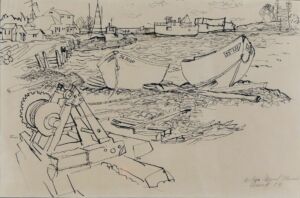May 24, 2023

Harbor – Grand Marais, 1954. Birney Quick (1912 – 1981) Ink on Paper. 18.525″ x 24.5″
Birney Quick (1912-1981) produced more than 10,000 works of art in his lifetime. He was a teacher, loved to fish, and founded the longest-running art colony in Minnesota. We have several of his works in Hennepin History Museum’s collection, including Harbor – Grand Marais created in 1954.
Born in Proctor, MN, Quick was raised in Duluth. He graduated high school in 1931, and traveled East to continue his education in art. He went to the Vesper George School of Art in Boston until 1934, as well as several art colonies in New York and Massachusetts. An art colony is a grouping or community of artists who reside in the same place. The places they reside in are often chosen for their beauty and low-cost of living. Art colonies have existed for hundreds of years, and there are many still in existence, such as the Woodstock Byrdcliffe Guild in New York, which Quick had studied at.
Quick was engaged in his programs and communities, actively pursuing opportunities to learn. In 1936, Quick was awarded the Louis Comfort Tiffany Foundation fellowship. This fellowship allowed him to study at the Tiffany estate, of Tiffany glass fame, at Long Island, NY for a summer. A year later, his first one-man show was at the Addison Gallery of American Art and one of his paintings was featured in the Art Institute of Chicago’s annual exhibition of American works.
Quick’s work and reputation were on the rise. He opened his own gallery in Duluth in 1937 and became an art instructor for the College of St. Scholastica. He then joined the Army Air Corps as an air corps artist from 1942 to 1946. During his service, Quick painted murals at the Keesler Base in Biloxi, Mississippi. After being honorably discharged, Quick began teaching at the Minneapolis School of Art, now the Minneapolis College of Art and Design, or MCAD.
Soon after he began teaching at MCAD, Quick and his colleague Byron Bradley became interested in starting an art colony. Quick suggested Grand Marais. Northern Minnesota is known for its beauty, so it’s no surprise that Bradley agreed. This wouldn’t be the first art colony in Minnesota, (Jo Lutz Rollins helped move an arts colony to Stillwater in 1934), but it would become the longest running. Quick brought his suggestion to MCAD’s director, saying Quick would oversee the program. Thus, the Outdoor School of Painting was founded in 1947.
The first year, twenty students signed up for an eight-week summer course. Their routine during this eight-week period included outdoor painting classes and fishing. After two years, MCAD moved the classes to Red Wing to locate housing for students and reduce the travel time between MCAD and the colony.
In 1952, the city of Grand Marais successfully requested the colony return. The Outdoor School of Painting changed its name to the Town Hall Art Colony, as their lessons were held on the top floor of Grand Marais’s old Town Hall, above a one-room fire station and a library. The students lived in the city, taking small jobs to pay for their schooling.
In addition to the student workers, the colony introduced various art forms into the city. In 1956, lessons were expanded to include music and dance and the first year of concerts was a massive success, with over 2,000 tickets sold and visitors coming from Canada and Duluth. Cook County High School’s auditorium hosted the concerts. In addition to music, murals were painted on many of the city’s businesses and students sold their paintings at annual end-of-year exhibitions. Another sign of the colony’s presence, which I found especially fun, was the weekly fish fry. In 1956, the fish fry cost $.60 and included creek and rainbow trout.
Quick once said, “I started the school so I could go trout fishing.” He often went to lakes with a fishing rod and painting supplies, and depending on the day, focused more on one activity than the other. Quick finished many works of art while fishing, and he often extolled the importance of being in nature. “To me, there is something awesome and mysterious here [the woods] and I try to catch this feeling in my paintings.”
The art colony has gone through many changes since Quick first founded it. In 1958, MCAD decided to no longer pay for the colony, and Quick and Bradley turned it into a private venture. The colony moved into a former church building and became a non–profit organization in 1984, with its final name being “the Grand Marais Art Colony.” This was only three years after Quick passed away. The Grand Marais Art Colony is still running strongly, with more exhibits and studio spaces for its students. Quick’s work and passion inspired many artists, and his hand in starting the Grand Marais Art Colony has greatly influenced Minnesota’s art scene and the city of Grand Marais for many years to come.
Author Bio: Written by Summer Erickson, former Visitor Services Manager and Collections Assistant at Hennepin History Museum. Erickson graduated with a B.A. in Art History and Museum Studies from the University of St. Thomas in 2020. They cataloged HHM’s art collection in 2021. Erickson is currently working as a receptionist for MSS.
Bibliography
“Birney Quick: An Inventory of His Papers at the Minnesota Historical Society.” Minnesota Historical
Society Manuscripts Collection. Accessed Nov. 4, 2021. http://www2.mnhs.org/library/findaids/01086.xml
“Birney Quick Mixes Painting with Fishing.” Star Tribune. Aug 01, 1965.
https://startribune.newspapers.com/image/185100196/?terms=%22birney%20quick%22%20artist&match=1
Goetz, Kathryn R. “Grand Marais is home to Minnesota’s longest-lived art colony.” MNopedia. Mar. 26,
Ross, Ronald. “Birney Quick Pictures Tell Stories.” Star Tribune. April 30, 1961.
https://startribune.newspapers.com/clip/88333978/
Worrall, Jean. “Arts on the Rocks Flourish in Grand Marais Colony.” Star Tribune. Aug. 12, 1956.
https://startribune.newspapers.com/clip/88335491/
“Painter Birney Quick leaves legacy of art.” Star Tribune. Dec. 05, 1981.
https://startribune.newspapers.com/clip/83247780/obituary-for-birney-quick/
Peterson, Brent. “Column: Stillwater’s art colony remembered.” The Gazette. Sep. 25,
Sherman, John K. “New Showing Blends Fancy and Mysticism.” Nov. 15, 1959.
https://startribune.newspapers.com/clip/83247828/
Sherman, John K. “Quick Shows Touch of ‘Mystical Realist.’” Star Tribune. Oct. 20, 1963.
https://startribune.newspapers.com/clip/83249060/
Silence, Rhonda. “Remembering Birney Quick with a Quick Reflection.” Cook County News Herald. July
19, 2014. https://www.cookcountynews-herald.com/articles/remembering-birney-quick-with-a-quick-reflection/
“History.” Grand Marais Art Colony. Accessed Nov. 4, 2021. https://grandmaraisartcolony.org/history/
“Making a Place for ART.” Minnesota History, Summer 1997.
https://grandmaraisartcolony.org/wp-content/uploads/2018/10/MN-History-Article-Summer-1997_web.pdf
Pursley, Neil. “Robbinsdale’s Gallery 5004 Features Birney Quick.” CCXMedia. May 9, 2019.
https://ccxmedia.org/news/robbinsdales-gallery-5004-features-birney-quick/
 This blog was made possible in part by the people of Minnesota through a grant funded by an appropriation to the Minnesota Historical Society from the Minnesota Arts and Cultural Heritage Fund. Any views, findings, opinions, conclusions or recommendations expressed in this publication are those of the authors and do not necessarily represent those of the State of Minnesota, the Minnesota Historical Society, or the Minnesota Historic Resources Advisory Committee.
This blog was made possible in part by the people of Minnesota through a grant funded by an appropriation to the Minnesota Historical Society from the Minnesota Arts and Cultural Heritage Fund. Any views, findings, opinions, conclusions or recommendations expressed in this publication are those of the authors and do not necessarily represent those of the State of Minnesota, the Minnesota Historical Society, or the Minnesota Historic Resources Advisory Committee.
